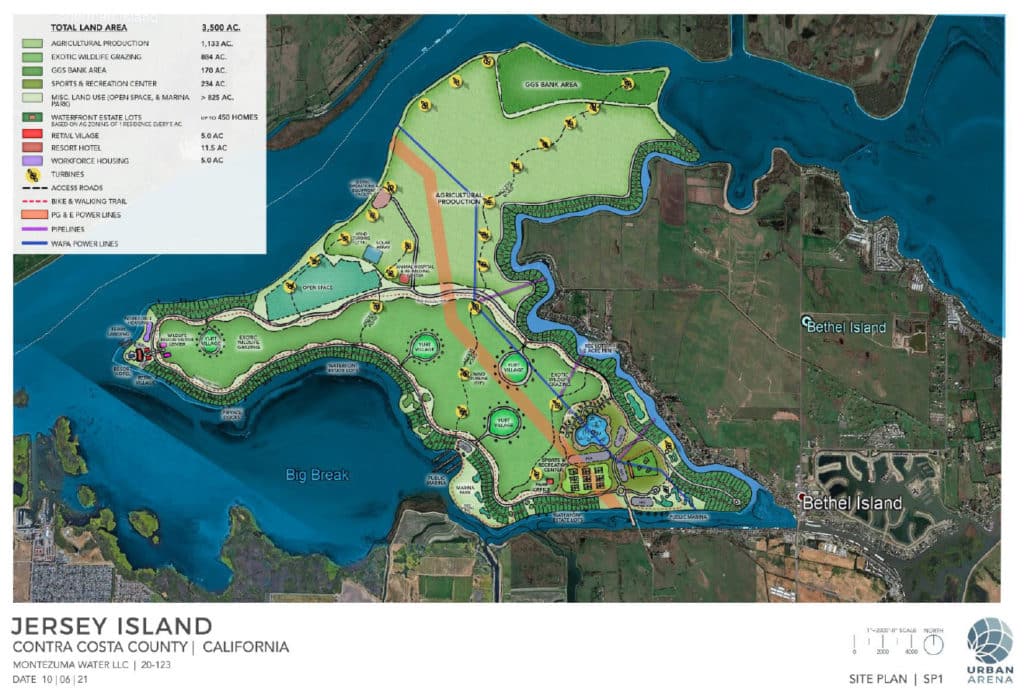On May 3, the Ironhouse Sanitary District Board of Directors passed a resolution approving the Jersey Island development proposal to move forward. As a result, Montezuma Water, the developer, will pursue inclusion of Jersey Island into the City of Oakley’s Sphere of Influence (SOI) over the next year. This is just the first step towards annexation of Jersey Island into the City of Oakley—a multi-year process—which would be necessary for the existing proposal (including 450 single family homes, a hotel, a sports and rec center, and a wild animal park) to move forward. Ultimately, Oakley residents will have to vote to extend the city’s Urban Limit Line—a boundary that marks the outer limit beyond which urban development will not be allowed—to allow for annexation.
At the May meeting, Leah Castella with the Ironhouse Sanitary District clarified that taking the next step in seeking to include Jersey Island in Oakley’s SOI allows for future provision of services, whether that be extensive infrastructure development necessary for the development proposal, or provision of basic services to support low-impact parks and recreation uses. Additionally, the Board Members thoughtfully deliberated in the meeting and raised many valid concerns, including:
- Director Lowrey voiced her concerns about flood impacts at the site
- Director Zirkle (the only vote against) shared his concerns about the significant traffic impacts this project would have and the infrastructure and service requirements of this development
- Director Lauritzen plainly stated “I’m not a fan of the project at all” and shared his experiences and concerns about building in a flood zone
Even with these concerns and unanswered questions, the Board of Directors saw more value in moving forward with entitling the site rather than starting the process from scratch, resulting in the conditional approval of the proposed new use.
Gearing up to the May Board meeting, Greenbelt Alliance met individually with Ironhouse Sanitary District Board Members, Supervisor Burgis, County staff, the Montezuma team, and other stakeholders to share information on the risks this sprawl development poses to climate goals, economic viability, and public safety. While we are disappointed with the outcome of the most recent meeting, we will continue to advocate for more appropriate land uses on Jersey Island in the year ahead.
What’s At Stake
Like many sprawl developments, the proposed project includes greenwashed language to describe potential site elements, such as “habitat refuge”, “specialty agriculture”, “mitigation”, and “clean energy”, but a deeper dive into the proposal tells a much different story.

This proposed development includes 450 new single-family homes along the waterfront of Jersey Island. Placing homes on an island with minimal access to jobs and no transit connectivity will increase vehicle miles traveled (VMT) and associated greenhouse gas emissions (GHGs). Locating homes here will set the County back on both climate mitigation goals and sea level rise adaptation. Simultaneously, without adequate protection from flooding and sea level rise, the long-term safety of residents will be threatened and will likely require costly protection measures from climate hazards in the near future.
Jersey Island’s largely undeveloped natural lands and its location adjacent to the Big Break Regional Shoreline have made it a haven for many of the Bay Area’s native avian and aquatic species.
The interior and northeast portion of the proposal shows roughly 800 acres of “wildlife and habitat refuge” including “significant visitor opportunities, including Safari tours of the rehabilitation and re-wilding centers and overnight stays with the animals.”
Greenbelt Alliance knows the value of habitat and restoration to restore natural systems and rebuild the Bay Area’s vital coastal ecosystems—but the existing development proposal does not reflect these values. Instead, it would introduce exotic non-native species to the island and further disrupt the essential habitat of existing species through development, increased traffic, and ecosystem disruption from new invasive species.
This is not the climate-smart development that Contra Costa County needs. Proceeding with this development will increase climate-related risks at the detriment of existing natural assets the area’s habitat, carbon sequestration, and associated ecosystem services provide.
Project History
On October 27, 2021, the proposal was presented to the Ironhouse Sanitary District (ISD) Board of Directors. They entered into an agreement with Montezuma Water LLC to consider new uses for Jersey Island in 2019. Jersey Island, located between Oakley and Bethel Island on the San Joaquin River, is currently owned and operated by the Ironhouse Sanitary District. The District uses the island for agriculture and grazing activities that use recycled water from the wastewater treatment plant to support production of over 2,000 tons of hay per year and support 2,200 head of cattle (ISD). Jersey Island is also the site of pipe infrastructure that transports recycled water from the wastewater treatment plant to an outflow in the San Joaquin River (Board Report).
The ISD issued a Request for Proposals (RFP) in 2018 to seek a partnership to consider alternative uses of Jersey Island. At that time, the ISD was motivated to issue an RFP because operation costs of the island (primarily levee maintenance and cattle operations) exceeded revenues. The ISD was also concerned about the liability of the levees and recognized in their RFP document that “most of Jersey Island is [4 to 18 feet] below sea level” and acknowledged that “climate change and associated sea level rise will significantly exacerbate this condition and place additional cost pressure on levee maintenance” (Board Report). In other words, the ISD is considering this new development to maximize revenue while also transferring liability for levee maintenance and sea level rise threats to the new inhabitants.
This proposed development may aid ISD’s near-term balance sheets, but it will come at an even greater cost to taxpayers and new residents as the adverse impacts pile up. Instead, we suggest ISD revisit the proposal to partner with East Bay Regional Parks District (EBRPD) to further develop Jersey Island’s recreational and habitat uses, which would conform with the County’s existing zoning, not require an extension of the Urban Limit Line, and provide increased recreational amenities and access to the Delta without putting people, and infrastructure, at risk of climate impacts.





